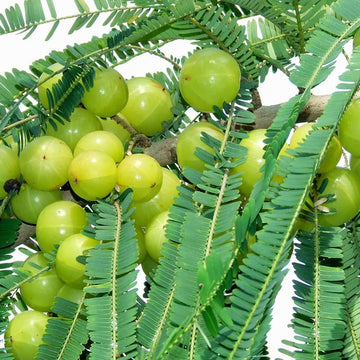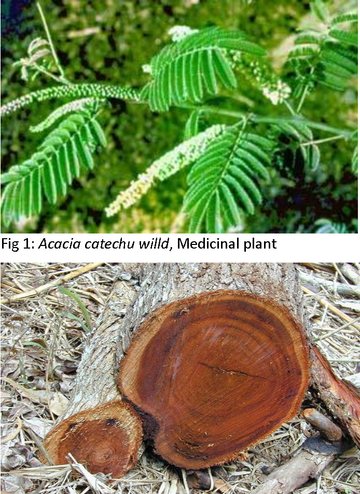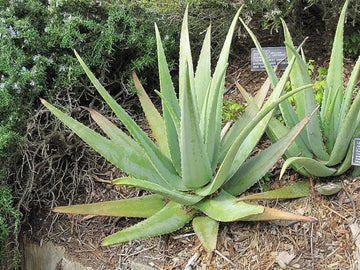ENGLISH NAME:-Emblic Myrobalan. Hindi - Amla
SYNONYMS
Sanskrit : Ëmalaka, Am¤taphala, Dh¡tr¢phala
Assamese : Amlaku, Amlakhi, Amlakhu
Bengali : Amla, Dhatri
Gujrati : Ambala, Amala
Hindi : Amla, Aonla
Kannada : Nellikayi
Kashmiri : Embali, Amli
Malayalam : Nellikka
Marathi : Anvala, Avalkathi
Oriya : Anala, Ainla
Punjabi : Aula, Amla
Tamil : Nellikkai, Nelli
Telugu : Usirika
Urdu : Amla, Amlaj
BOTANICAL NAME - Emblica officinalis
FAMILY - EPHORBIACEAE
PARTS-USED:- Fruit and Seeds.
DESCRIPTION:- A medium sized tree, leaves small looking like tamarindus leaves, Flowers unisexual creamish yellow & small, fruits: fleshy globose.
Its tree is 20-25 feet tall of medium size. Stem bark greenish gray, thin, leaf-dropping. The leaf-stalks are oblong, leaf-oblong, arranged like feathers, like tamarind leaves. The inflorescence is long with small, yellowish flowers in clusters. Fruit-globose, 3-1 inches in diameter, fleshy, yellowish green, reddish when ripe with six lines on the outer surface indicating six segments. There is a hexagonal seed inside. Flowers in February-May and fruits from October to April. Leaves appear in March-April.
There are two types of amla. Wild amla is small, hard, sticky and rural amla is large, soft and fleshy.
a) Macroscopic (Fresh Fruit pulp)
Fruit, globose, 2.5-3.5 cm in diameter, fleshy, smooth with six prominant lines;
greenish when tender, changing to light yellowish or pinkish colour when mature, with a few dark specks: taste, sour and astringent followed by delicately sweet taste.
b) Microscopic (Fresh Fruit pulp)
Transverse section of mature fruit shows an epicarp consisting of single layer of epidermis and 2-4 layers of hypodermis; epidermal cell, tabular In shape, covered externally with a thick cuticle and appear in surface view as polygonal; hypodermal cells tangentially elongated, thick-walled, smaller in dimension than epidermal cells; mesocarp forms bulk of fruit, consisting of thin-walled parenchymatous cells with intercellular spaces, peripheral 6-9 layers smaller, ovoid or tangentially elongated while rest of cells larger in size, isodiametric and radially elongated; several collateral fibrovascular bundles scattered throughout mesocarp consisting of xylem and phloem; xylem composed of tracheal elements, fibre tracheids and xylem fibres; tracheal elements show reticulate scalariform and spiral thickenings; xylem fibres elongated with narrow lumen and pointed end; mesocarp contains large aggregates of numerous irregular silica crystals.
c) Macroscopic (Dried fruit)
Drug consists of curled pieces of pericarp of dried fruit occuring either as separated single segment; 1-2 cm long or united as 3 or 4 segments; bulk colour grey to black, pieces showing, a broad, highly shrivelled and wrinkled external convex surface to somewhat concave, transversely wrinkled lateral surface, external surface shows a few whitish specks, occasionally some pieces show a portion of stony testa (which should be removed before processing); texture rough, cartilaginous, tough; taste, sour and astringent.
d) Microscopic (Dried fruit)
Transverse section of fruit shows epicarp consisting of a single layered epidermis, cell appearing tabular and poygonal in surface view; cuticle present; mesocarp cells tangentially elongated parenchymatous and crushed, differentiated roughly into peripheral 8 or 9 layers of tangentially elongated smaller cells, rest consisting of mostly isodiametric larger cells with walls showing irregular thickenings; ramified vascular elements occasionally present; stone cells present either isolated or in small groups towards endocarp ; pitted vascular fibres, walls appearing serrated due to the pit canals, leading into lumen.
Powder: Fine powder shows epidermis with uniformly thickened straight walled,
isodiametric parenchyma cells with irregular thickened walls, occasionally short fibres and tracheids.
Origin - Occurs everywhere in India up to 4500 feet.
TASTE:-Sour, Astringent, Sweet.
CHEMICAL CONSTITUENTS-Fruit Contains: Protein, Fats, Fibres, Carbohydrates, Vitamin-C, Nicotinic acid, Tannins; Afterdrying it contains Gallic acid, Ellagic acid and Flavin & Glucose, Seeds Contains: Linoleic acid, Linolenic acid and Oleic acid.
ACTIONS:-Tonic, Diuretic, Astringent, Cooling, Antifungal, Laxative, Liver tonic. Anodyne, carminative, stomachic.
USED IN:-Haemorrhage, Diabetes, Polyuria, Headache, Hysteria, Jaundice, Eczema, Disuria, Piles, Diarrhoea, cold, Menorrhagia, Scurvy. dyspepsia, flatulence, menorrhagia.
USES :- Beneficial in bleeding, diabetes, gonorrhea, headache, unconsciousness, jaundice, itching, dysentery, diarrhea, catarrh, menorrhagia and cold (malaria).
- Decoction of leaves is beneficial in mouth ulcers. Amla powder and turmeric powder are beneficial in diabetes (take one spoon after eating food).
- In case of gonorrhea, making a decoction of dried Indian gooseberry powder and adding two grams of turmeric powder and honey to it is beneficial.
- In case of hoarseness - consuming gooseberry powder mixed with cow's milk is beneficial.
- Benefits of consuming dried gooseberry powder mixed with twice the amount of sugar and twice the amount of ghee in bile are beneficial. In case of dysuria, consumption of fresh Amla fruit juice and sugarcane juice together is beneficial.
- In case of vaginitis- consuming sugar candy mixed with gooseberry fruit juice is beneficial.
- Benefits of consuming fresh Amla fruit juice mixed with cow ghee to increase sperm count.
- To ward off old age: Mixing dry gooseberry powder and sesame powder in equal amounts and consuming it with ghee and honey for 20 days is beneficial.
- In case of bile colic – consuming dried Indian gooseberry powder mixed with honey is beneficial.
- In case of fever, the patient who does not sleep or sweat and cannot hide his thirst, should be given a drink of gooseberry and ginger mixed with ghee and sugar candy.
- In case of fever, fever is cured by consuming Amla juice mixed with ghee.
- In case of Raktaarsh, one should consume Amla juice mixed with cream on top of curd.
- In case of white leucorrhoea (1) Amla seed powder mixed with honey and sugar candy should be consumed. (2) Amla powder or juice mixed with honey should be consumed.
- Amla juice or powder mixed with honey should be consumed in blood and bile. Swaras is especially beneficial in this.




